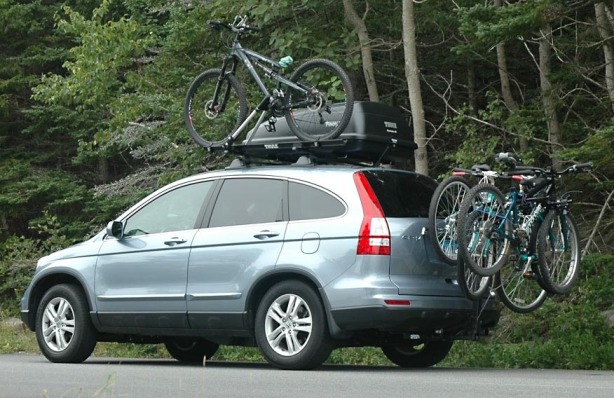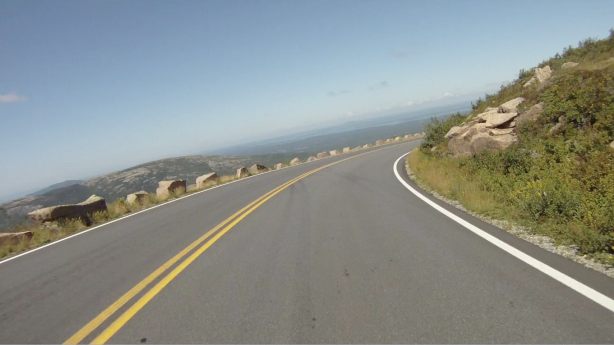Each August, my family and I spend a vacation week in Gloucester, Massachusetts. In spite of the overabundance of “not-happy-out-of-first-place” Sox fans, it’s a very pleasant area. Great beaches and good, fresh seafood. For this annual road trip, we take my wife’s “family” car, instead of my manual transmission equipped “driver’s” car, which is seriously lacking in cargo space. Since 2001, Joanie has been driving a Honda Odyssey minivan. First a 2001 EX, and then a 2006 EX-L. Personally, I think the current generation Odyssey is one of the best all-around vehicles on the road. It does everything well, and equipped as our 2006 was with the 255HP VCM (variable cylinder management) V-6, it has plenty of power. With VCM, you get more than respectable gas mileage on the highway. Plus, the Odyssey has tons of room and will carry 8 full-size passengers, or 5 people and lots of gear.
With our kids both in the teen years, and with her business requiring a lot of driving, Joanie decided to get something smaller, more fuel efficient, and more maneuverable, but with all-wheel drive. While I was away on a trip, she and the kids test-drove the three vehicles on her short list: the Honda CR-V, Subaru Forester, and the newly redesigned Subaru Outback. The RAV4 didn’t make the cut since she doesn’t like the design, especially the spare tire mounted on the rear door. Upon inspection, the Forester seemed a bit too austere and somewhat cramped, so that was out. I was trying to steer her towards the Outback, but she liked the higher driving position and interior design of the Honda. So Joanie went with a loaded 2010 Glacier Blue Metallic CR-V EX-L with Navigation and “Real Time™” 4-Wheel Drive (as opposed to “tape-delayed” 4-wheel drive?).
Prior to our annual journey north, I had driven the CR-V on some short trips and while the overall car is very solid, with better than expected handling, good interior design, and typical first-rate Honda build-quality, it felt a bit anemic in terms of power— especially climbing the hills around our home. For the record, the 2010 CR-V received a bump in power to its 2.4 liter 4-cylinder from 166 to 180HP, while torque stayed at a rather wimpy 161 lb-ft. Fuel economy ratings also rose a bit to a “claimed” 21 city and 27 highway.
Accessory time
For this year’s trip, we decided to spend four days at Acadia National Park near Bar Harbor, Maine, before hitting Gloucester for a couple of beach days. Acadia is really spectacular with more than 125 miles of hiking and biking trails, plus one of the most picturesque coastlines in North America. Since we would be bringing our mountain bikes, hiking boots, backpacks, boogie boards and other beach gear, the CR-V’s 35.7 cubic feet of cargo capacity would need some significant expansion.
Addressing the bikes first, I installed a Hidden Hitch class I trailer hitch and a Hollywood Racks 4-bike hitch mount rack. While the hitch install required dropping the muffler from its rubber mount, the overall installation was fairly straightforward. Next up was a roof cargo box. I’ve always been a fan of Thule’s products, and since I already own Thule crossbars, we went with their rear-opening Excursion ES box. Here’s a tip for those under 6’4″—get a folding step stool to make loading and unloading the roof box a much easier affair. To balance the load a bit, I put my dual suspension bike on the roof alongside the box filled the with beach gear. The other three bikes went on the hitch rack, after filling the space behind the rear seats and closing the tailgate. Access to the area behind the seats would be from the interior while the bikes were in place. With the car loaded up, and the dual screen DVD player strapped in place, we hit the road.
Torque? Where’s the torque?
I have driven quite a few underpowered cars over the years. Most of them made no pretenses as to being anything more than what they were. If equipped with a manual trans, you just kept the revs up and made the best of it. The CR-V however claims to be “powerfully efficient.” And it’s an SUV, a class of vehicle that has come to represent a certain level usability and performance. So, I expected it to at least have enough power to keep up with traffic. I was wrong. The CR-V’s 4 banger is in way over its VTEC-equipped head, especially when loaded. Compared to other compact SUVs I have driven recently (Ford Escape, Acura RDX, etc) the CR-V’s 2.4 felt very inadequate. Accelerating onto the highway was a foot-to-the-floor and hope-for-the-best experience.
Setting the cruise control at 65 caused the automatic transmission to constantly downshift, searching for more power. After 10 minutes of this herky-jerky behavior, and the fuel economy readout showing 17.4 mpg, I switched off the cruise. By modulating the pedal myself, and not trying to maintain speed on uphills, the mileage picked up a bit. But on long grades, we were hanging in the slow vehicle lane. Considering we had an eight-hour ride, this was not a lot of fun. Trying to pass another car or tractor-trailer took serious patience. But the ride was comfortable and the brakes and suspension seemed to handle the full-load quite well. When we got to Bar Harbor, we found the relatively short CR-V was easy to park in most parallel spots, even with the bike rack on back.
Time for some sightseeing: Cadillac Mountain in Acadia National Park is one of the highest points in the Northeast. For much of the year, this is the first point in the US to see the sunrise. The road to the top is a series of switchbacks and ends at the 1528 foot summit. The CR-V chugged along, eventually reaching the top. After looking around at the fantastic vistas, my son Ben and I decided to do the descent on our bikes, instead of the car. A great decision. View a clip of the GoPro HD video here.
Range? What range?
In terms of comfort and features, the CR-V proved to be a good long-haul vehicle. Both front and rear seats are supportive and the rears have adjustable incline. The Honda Satellite-Linked Navigation worked really well, the ride was smooth and the dual-range climate control kept the interior comfortable. Unfortunately, the Thule box created a fair amount of interference with the satellite radio antenna, so the tunes tended to cut in and out a bit. But Joanie had brought along Harry Potter book 7 on audio CD, so we had interference-free entertainment along the way.
The most surprising thing about the 1200-mile, 6-day trip, was the CR-V’s mileage and range. We averaged 19.5 MPG over the entire journey. With a 15 gallon tank, and not wanting to drop below a ¼ tank, I was stopping every 200 miles or so for fuel. Now, 19.5 MPG may sound great if you’re driving an Excursion or Suburban, but for a compact SUV, especially one from Honda, this is downright unacceptable. Considering how anemic the engine is in performance, the poor fuel economy is even more disappointing.
Now what?
For a company that has produced some really great cars and engines over the years, Honda needs to rethink the CR-V’s powerplant. A suggestion? Use sister (daughter?) company Acura’s version of the 2.4 liter VTEC. In the TSX, the 2.4 makes 201HP and 170 ft-lbs at a lower rpm than in the Honda. As it is, the CR-V is okay. But it could be great. It just needs a decent heart. As for Joanie, she still loves the Honda, and equipped with 4 snows, it’s a real mountain goat in the winter. But when she’s ready for her next car, I think I’ll go along for the test drive to see what’s under the hood. I wonder what she would think of the new Ford Explorer with the 237HP EcoBoost turbo 4…

